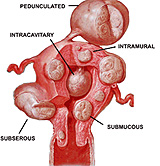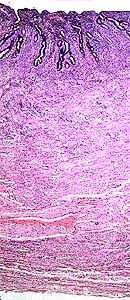Uterus -- site of
implantation and growth of embryo.
Clinical note: Smooth muscle
cells of the uterus commonly give rise to benign tumors called
leiomyomas or fibroids, which usually do produce major medical
problems but grow slowly and often attain diameters of several
centimeters.
Examine a trichrome-stained section
of uterus and identify the
- Endometrium,
- Myometrium,
- Perimetrium with serosa, and
- The attached connective tissue.

Examine the endometrial surface and note the simple columnar epithelium. Throughout the endometrium, identify endometrial glands and vascular sinuses in the
stroma. You may be able to distinguish the basal layer and
functional layer of the endometrium, but this is difficult on slide
1. In the myometrium, observe the interlacing bundles of smooth
muscle fibers.
Describe the major changes in
the endometrium during the menstrual cycle.
What exactly is lost during menstruation?
Clinical note: Endometriosis,
a common medical problem of the female reproductive system, results
when sloughed endometrial tissue is refluxed up the uterine tubes
and surviving cells begin to grow on the surface of the ovary,
mesenteries, or other organs in the peritoneal cavity. Cycles of
growth and loss of this displaced endometrial tissue occur under the
influence of estrogen and progesterone, which can eventually result
in inflammation, pain, and scarring of the affected organs.
Untreated, endometriosis can lead to infertility for several
reasons.
Now for the
cervix and vagina. |